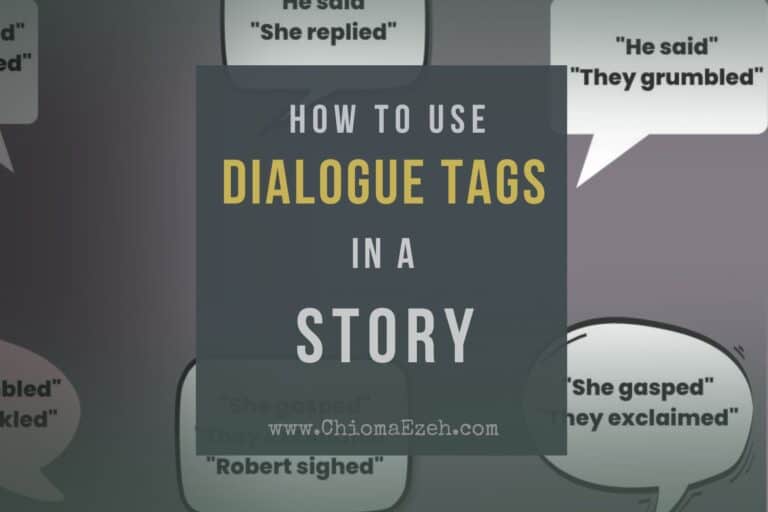How To Write Dialogue In A Story: 7 Simple Steps
Dialogue is a crucial element of a story that gives life to your characters, drives your narrative forward, and keeps your readers engaged. Effective dialogue reveals your characters’ emotions, motivations, and relationships while creating tension and conflict in your story.
In this article, you will learn how to write dialogue in a story. We will explore the importance of dialogue in a story and provide a step-by-step guide to writing dialogue, along with practical examples.
👉See our overview guide to writing dialogue for authors

Let’s Talk
Are you a writer aspiring to pen a masterpiece that never fails to captivate? Look no further. Reach out to us and uncover how we can help you to take your writing to unprecedented heights!

How to Write Dialogue in a Story with Examples
We’ve outlined 7 tips to write dialogue in a story. If you want to learn how to start dialogue in your story, you might as well check out this article.
1. Keep it Natural and Realistic:
Pay attention to the rhythm, pacing, and flow of real-life conversations when writing dialogue. Use contractions, colloquialisms, and informal language to make your characters sound more authentic.
Example:
Good: “I cannot believe you would do such a thing! It is unbelievable!”
Better: “I can’t believe you’d do that! It’s unbelievable!”
However, avoid overusing filler words or stutters, which can slow down the pace and distract the reader.
For example,
Incorrect: “Umm, I uh… want to go to the store.”
Correct: “I want to go to the store.”
👉See our guide to the impact of dialogue on the pacing of a story
2. Create Distinct Character Voices:
Dialogue affects the character in so many ways. Try to develop unique voices for each character. Voices should reflect their personality, background, and experiences. Use vocabulary, speech patterns, and sentence structures that suit each character.
Example:
Character A (formal, educated): “I’ve perused the document, and it appears we must take action posthaste.”
Character B (casual, laid-back): “I’ve checked it out, and it looks like we gotta do something, pronto.”
3. Use Subtext and Indirect Speech:
Subtexts are used to imply deep meanings to a speech or dialogue. Engaging dialogue often conveys meaning through what isn’t explicitly stated. Use implication, innuendo, or understatement to add depth and nuance to your characters’ conversations.
Example:
Direct: “I don’t like you. You’re always so arrogant.”
Indirect: “You know, a little humility wouldn’t hurt now and then.”
👉To learn more, read our post on subtexts in dialogue writing
4. Incorporate Conflict and Tension:
Use dialogue to introduce tension, disagreements, misunderstandings, or power struggles between characters to create dynamic conversations. This will heighten the stakes and keep readers engaged.
Example:
Character A: “You never listen to me! I told you not to go in there, and now look what’s happened!”
Character B: “Oh, so now it’s my fault? Maybe if you were clearer, we wouldn’t be in this mess!”
👉See our guide on using dialogue to create tension
5. Balance Dialogue with Action and Description:
To create a well-rounded narrative, intersperse dialogue with action and exposition. You can also use action beats to show characters’ emotions, thoughts, and reactions. This will make the reading experience more immersive.
Example:
Character A: “I can’t believe you said that!” (Character A’s face flushed with anger, her hands balled into fists at her sides.)
Character B: “I’m sorry; I didn’t mean to upset you.” (Character B glanced away, shame evident in his expression.)
👉See our author guide on writing effective action beats in dialogue
6. Use Dialogue Tags and Beats Effectively.
Use dialogue tags such as ‘said’ or ‘asked’ sparingly, as they can become repetitive and distracting. Instead, incorporate alternatives to said, or use action beats to show which character is speaking and convey emotions or reactions.
Example:
Character A: “Where were you last night?”
Character B hesitated, avoiding eye contact. “I was just hanging out with some friends.”
Character A raised an eyebrow. “Really? Because I saw your car parked outside the bar.”
👉To learn more, read our guide to using dialogue tags correctly
7. Format and Punctuate Dialogue Correctly:
Ensure that your dialogue is formatted and punctuated correctly to make it easy for readers to follow the conversation. Begin a new paragraph each time a different character speaks, and use quotation marks and other appropriate dialogue punctuation.
Example:
Incorrect: “What are you doing here? He asked.”
Correct: “What are you doing here?” he asked.
The above often applies to writing dialogue between two characters in a story. To write a dialogue between three characters in a story, let’s consider the following tips next.
👉Read our expert guide to formatting dialogue for authors
How To Write Dialogue Between Three Characters In A Story
Writing dialogue between three characters in a story can be challenging, as it requires careful attention to each character’s voice and the conversation’s structure. Here are some tips for crafting engaging dialogue between three characters, along with examples:
1. Establish distinct character voices:
Each character should have a unique voice that reflects their personality, background, and emotions. This helps readers distinguish between the characters and makes the dialogue more engaging.
Example:
“Hey, Jack, did you see the game last night?” asked Tom.
“No, I was working late,” Jack replied with a sigh.
“Lucky you,” chimed in Sarah, “It was a disaster.”
2. Use clear dialogue tags and action beats:
With three characters, it is important to clarify who is speaking. Use dialogue tags (e.g., he said, she asked) or action beats (e.g., John frowned, Mary nodded) to help readers follow the conversation.
Example:
“I can’t believe we’re stuck here,” Emily complained.
“Could be worse,” Sam said, trying to lighten the mood.
Olivia rolled her eyes. “Not by much, Sam.”
3. Manage conversation dynamics:
In a conversation with three characters, balance each character’s contribution and ensure no one dominates the discussion.
Example:
“Where should we eat tonight?” asked Laura.
“I’m in the mood for sushi,” Mark suggested.
“Sounds good to me,” agreed Karen. “There’s a new place nearby we could try.”
4. Vary the dialogue structure:
Mix up the order in which the characters speak and use interruptions, overlaps, or pauses to create a dynamic conversation that feels natural and engaging.
Example:
“I don’t think we should go there,” Adam began.
“But it’s the only option,” interrupted Eve.
“No, wait,” said Ben, “I think I have another idea.”
5. Balance dialogue with narrative:
Use narrative descriptions and actions to maintain the story’s pace, provide context, and show the characters’ emotions, reactions, and body language during the conversation.
Example:
“I can’t believe he’s gone,” whispered Anna, her voice trembling.
David put his arm around her. “He was a great man.”
From across the room, Helen nodded solemnly. “We’ll all miss him.”
6. Advance the plot or develop characters:
Each conversation should serve a purpose – whether it’s advancing the plot, revealing character traits, or creating tension. Make sure the dialogue between the three characters contributes to the story.
Example:
“Did you find any clues?” asked Detective Harris.
Officer Brown shook his head. “Nothing yet.”
“Well, keep looking,” insisted Chief Miller. “We need to solve this case.”
Remember to keep the dialogue focused, purposeful, and authentic. Make sure that each character contributes to the conversation. With practice, you can create engaging and meaningful dialogue between three characters in your story.
👉For deeper insight, read our guide on writing dialogue for three characters
Why Is Dialogue Important in a Story?
There are several reasons dialogue is important in a story. Writers often craft dialogues in stories for more or more of the following reasons:
- Character Development: Dialogue allows you to showcase your characters’ unique personalities, backgrounds, and attitudes. This makes them feel like real people to your readers.
- Plot Progression: Dialogue plays a vital role in moving the story forward. Characters can exchange vital information, make decisions, or reveal secrets that impact the narrative’s direction.
- Conflict and Tension: Engaging dialogue often features conflict and tension between characters. Disagreements, power struggles, or hidden motives can create suspense, keeping your readers intrigued and invested in your story.
- Exposition and World-Building: Dialogue can effectively convey information about your story’s world, history, or backstory without resorting to lengthy descriptions or info-dumps.
👉Read more on the importance of dialogue in a story
Video Recommendation: How To Write Dialogue In A Story
In this video, Jerry B. Jenkins provides examples of effective and ineffective dialogue and offers valuable insights and practical strategies for crafting authentic and captivating conversations between characters. This video is an excellent resource for aspiring writers who want to enhance their skills in dialogue writing.
FAQs On How To Write Dialogue In A Story
What Are The Key Elements Of Writing Effective Dialogue?
The key elements of writing effective dialogue include making it sound natural, developing character voice, using purposeful dialogue, balancing dialogue with narrative, and incorporating subtext and conflict.
How Can I Make My Dialogue Sound More Natural And Authentic?
To make dialogue sound more natural and authentic, listen to real conversations, pay attention to the speech patterns of different people, avoid overusing formal language, and ensure that each character has a distinct voice.
How Do I Balance Dialogue With Narrative In My Story?
To balance dialogue with narrative, ensure that conversations serve a purpose, such as advancing the plot or revealing character traits, and avoid lengthy exchanges that do not contribute to the story. Also, intersperse dialogue with narrative descriptions and action, allowing the pace to ebb and flow naturally.
What Are Some Common Mistakes To Avoid When Writing Dialogue?
Some common mistakes to avoid when writing dialogue include using too much exposition, making all characters sound the same, relying heavily on dialogue tags, overusing adverbs, and not using contractions or colloquial language to create a natural flow.
Final Notes On How To Write Dialogue In A Story
Engaging dialogue brings your characters to life, propels your narrative, and captures your readers’ attention. Follow the above tips to create realistic, dynamic conversations that contribute to the overall success of your story.
Always keep the dialogue natural, give each character a distinct voice, and strike a balance between dialogue, action, and description to create a compelling, immersive reading experience.

![What Are The Types Of Dialogue In A Story? [Explained]](https://chiomaezeh.com/wp-content/uploads/2023/03/types-of-dialogue-in-a-story-1-768x512.jpg)

![What Is Second Person Point Of View? [Definition & Examples]](https://chiomaezeh.com/wp-content/uploads/2023/03/second-person-point-of-view-1-768x512.jpg)


